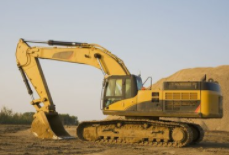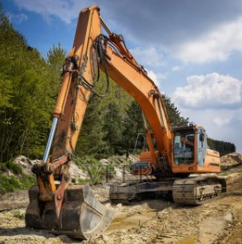Talking about the common faults of excavators
A. Reasons for “jumping”
(1) Wear of the transmission mechanism of the transmission mechanism W4-60 type excavator adopts the transmission mechanism of mechanical shifting and transmission. This transmission mechanism relies on the sliding tooth sleeve to move axially on the fixed tooth sleeve and is connected with the driven gear of each gear. engaged to achieve shifting. In the process of frequent shifting, the end faces of the gear teeth of the above-mentioned meshing gears are easily ground into a conical shape, which reduces the meshing performance and causes “jumping gears”.
(2) The performance of the self-locking mechanism is degraded. In order to prevent the transmission from “jumping”, this type of excavator is installed in the box cover holes above the fork shafts of the Ⅱ, Ⅲ and Ⅳ and Ⅴ gears of the transmission and in the Ⅰ and reverse shift forks. There are steel balls and springs that play a self-locking role. When the elasticity of the spring that plays the role of positioning and self-locking is weakened or broken, the self-locking performance of the self-locking mechanism will decrease until it disappears, causing the transmission to “jump”. At the same time, if the groove on the positioning steel ball or the fork shaft is worn, it can also cause the transmission to “jump”.
(3) Improper adjustment of the shifting device The transmission of this type of excavator adopts a mechanical manual shifting method. If the shift lever, vertical axis, horizontal axis and vertical fixing screws are loose, the transmission can also “jump”.
(4) Sudden change of external load Due to the working nature of the excavator and the design of the machine itself, the sudden change of the external load will also cause its transmission to “jump”. When the road surface is uneven, the machine is driving downhill or the driving route is improper and the external load changes suddenly, the sudden change of the load will act on the gear meshing gear of the transmission through the wheel and drive shaft, so that the gear meshing gear Disengagement due to axial thrust, resulting in a “jump” of the transmission.
(5) Improper operation method When the excavator is driving on a slope (especially driving downhill), if the operation is improper, it will also cause the transmission to “jump”.
B:Preventive measures
(1) Operate in strict accordance with the operating procedures and driving essentials, and try to avoid “beating teeth” when shifting gears to reduce the wear of the gear pair.
(2) Strictly implement the maintenance system and strengthen the maintenance of the shifting device. When the lever system of the shift device is not connected properly, it should be adjusted in time to ensure the good performance of the shift device.
(3) Pay attention to the repair and maintenance of the self-locking mechanism, and repair or replace the positioning steel balls, springs and fork shafts with reduced positioning effect or loss of positioning efficiency in time, so that the self-locking performance of the self-locking mechanism is in a good state. .
(4) When assembling the transmission, it should be operated in strict accordance with the operating procedures to ensure that the various parts of the transmission are properly adjusted and properly tightened. On a large downhill road, the driver should strictly follow the downhill action essentials, and must not violate the regulations.
C:Emergency Response Methods
During the driving process of the excavator, if the transmission “jumps”, the machine should be stopped in time (or continue to drive), and then find the cause and eliminate the fault. The specific method is:
(1) If there is a “jump” when driving on a flat road, you can stop the machine according to the normal shutdown method, carefully find the cause, and eliminate the fault.
(2) If there is a “jump” when driving uphill, you can set the gear to the low-speed position or the first gear position, and wait for the machine to stop when it reaches the top of the slope to eliminate the fault; if the downshift is unsuccessful or occurs again When “jumping the gear”, stop the machine according to the action essentials and requirements of the ramp stop, and then troubleshoot.
(3) When a “jump” occurs when driving on a downhill, the gear should be set to a high-speed position according to the action essentials of upshifting, or a “snatch” (emergency downshift) measure should be taken, and wait for the machine to drive to the bottom of the slope. Stop the machine again to check and troubleshoot;
if the “upshift” and “grab” are unsuccessful or the “skip” occurs again (neutral at this time), the driver can control the engine speed at medium speed (to prevent the engine from stalling) , use the “point brake” method to make the machine slide to the bottom of the slope, and then troubleshoot.
If the “upshift”, the “grab” is unsuccessful, or the “jump” occurs again (this time it is neutral), and the machine is in the downhill slope again
(at this time, the machine will go to the bottom of the slope at a very fast speed” “Dive”),
you should quickly stop according to the action essentials and requirements of downhill stop, and then deduct the fault.

1: Whether the pilot pressure of the rotary operation is within the normal range (the normal pilot pressure is above 35KG);
2: The rotary relief valve is damaged, whether the rotary relief pressure is within the normal range (overflow pressure: 280KG);
D:Whether the rotary main spool is switched in place, and whether the return spring of the rotary spool is broken;
E: The distribution valve is worn and damaged, causing the internal leakage of the rotary motor;
F:The pump body and plunger of the rotary motor are worn and damaged, causing the motor to leak;
G: only if the rotation action is slow and other actions are normal, the failure of the hydraulic main pump and main relief valve can be ruled out;
Post time: Jul-16-2022





